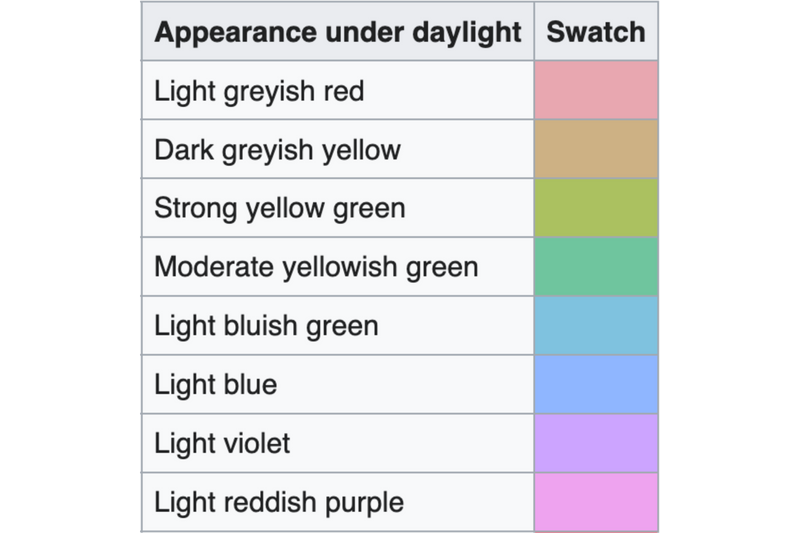It's illegal to buy healthy lightbulbs in California
You probably already know that blue light is bad for sleep quality.I’ll write more about this in the future, but for now, some sources: 1, 2, 3, 4.
But what you might not know is that the LED lightbulbs that you almost certainly have in your home emit significant blue light — even the ones that look reddish.
Here’s a nice chart of color temperatures from Simon Sarris:

2700K looks like a nice evening light, right? Well, here’s a spectrogramSpectrograms show the intensity of the various components of a light source. I use a Gossen Mavospec spectrometer to collect raw intensity data, and these charts show that data indexed to the highest level found in the sample. for a 2700K LED bulb I found lying around:
See that spike of blue? That’s bad for sleep.
That spike appears in pretty much every common LED bulb to some degree, because those bulbs use a blue LED as their light source, which is then absorbed by a phosphor coating and re-emitted to form the overall light you end up seeing. But a big chunk of the original blue remains (and often gets worse as the bulb ages).
Now, you’re probably wondering why I said it’s illegal to buy healthy lightbulbs in California.
Well, you might hear about this problem with LEDs and think: I should find old-school lightbulbs that don’t have that blue light spike. Something like incandescent or halogen bulbs. Here’s an incandescent:
So nice! Incandescents have beautiful spectra (and are what I use for evening lighting).
Unfortunately, general-use incandescent bulbs are illegal to sell in the United States as of 2023See here for context. I think this is insane given how strongly light quality can affect health, and I’m guessing we’ll come back around to this issue in the same way we’re currently revisiting the (also insane) intentional fluoridation of tap water.. It’s not really policed, though, so you can usually find them even on Amazon if you poke around.
But if you live in California, you’re subject to an even more draconian regulation: CA Title 20, which regulates “appliance efficiency.” Even separate from the federal legislation, incandescents are illegal to sell in California, and it is actively enforced.
So if you try to ship incandescents from Amazon to a California address, you’ll get this:

“No problem,” you might say, “I’ve heard there are LEDs that don’t have any blue light! They might be pricey, but it’s worth it for my sleep quality.”
And you’d be right! There do exist bulbs like the Soraa ZeroBlue LED, which are built in a different wayMost importantly: they are violet-pumped rather than blue-pumped. Russell Graves has a great writeup about this. and don’t emit blue light. Here’s their spectrum (that’s a violet spike, with nearly no sleep-damaging blue):
Nice! A bulb with no blue light that is energy-efficient enough to be legal to buy… right?

Hmm… what’s this? It’s an energy-efficient LED, so California shouldn’t have an issue with it.
Well… part of CA Title 20 is this little clause:
State-regulated LED lamps with lumen output of 150 lumens or greater for E12 bases, or 200 lumens or greater for E17, E26, and GU24 bases, and manufactured on or after January 1, 2018, shall meet all of the standards shown in Table K-3 and shall have the following:
…
2. A CRI (Ra) of 82 or greater.
California — being a bit of a nanny state, as usual — wants to make sure that you don’t buy any bulbs that have a poor “Color Rendering Index.”
If you go read about CRI, you’ll see a bunch of complicated formulas and processes. But it basically boils down to this:
For each of the eight (yes, just eight) color swatches below, when they’re lit by the bulb in question, how close to the “ideal” color are they?

See the problem here?
Two of the swatches are blue.
So if we have a bulb that intentionally emits no blue light… it’s probably not going to score great on this test.
Lo and behold, the Soraa ZeroBlue comes in with a CRI score of 80.
Is that because it’s a low-quality bulb letting off low-quality light? Not at all — just the opposite. It’s really quite good.
But because of the lack of blue, it has a low CRI. And because it has a low CRI, it can’t be sold in California or shipped to California addresses.
The issue is that it doesn’t have enough of the unhealthy blue lightTo be clear: blue light isn’t always bad — in fact, during the day, it’s necessary. But most of our home light use is in the evening, and blue light then becomes a problem..
And so, if you want healthy lightbulbs in California… you’re in a tough spot. No incandescents, no zero-blue LEDs.
Without going to great lengths, you’re stuck with melatonin-disrupting bulbs. Enjoy your blue light.
Like I said: it’s illegal to buy healthy lightbulbs in California.
Looking for more to read?
Or, more on light:
Russell Graves’ blog has a number of excellent posts on LEDs and lighting in general. I’d start with “How Your LED Lights and Screens are Killing You.”
Simon Sarris also has a good piece on lighting in homes.
And for even more...
Want to hear about new essays? Subscribe to my roughly-monthly newsletter recapping my recent writing and things I'm enjoying:
And I'd love to hear from you directly: andy@andybromberg.com